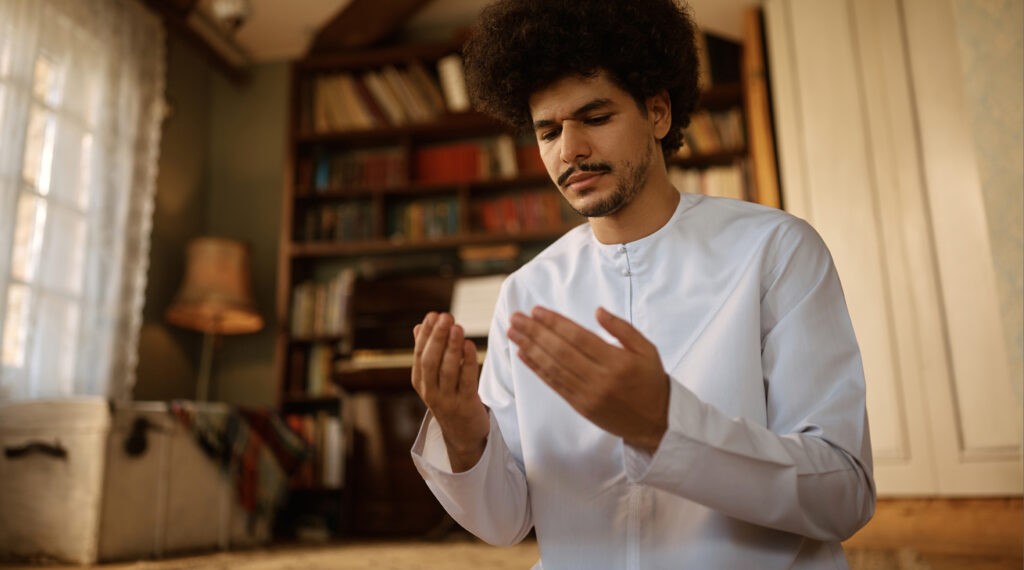How to Pray Tahajjud—A Path to Spiritual Renewal

Tahajjud, also known as the Night Prayer (or Salat al-Layl), is a highly esteemed voluntary prayer in Islam performed during the late hours of the night, specifically after the Isha prayer and before the Fajr prayer.
The Tahajjud prayer is revered for its spiritual significance, as it involves sacrificing sleep to engage in deep worship and reflection. For those seeking guidance on how to pray Tahajjud, this sacred time offers a unique opportunity for believers to disconnect from worldly concerns and focus solely on their relationship with God.
Tahajjud is an opportunity to seek God’s mercy and blessings through heartfelt supplication. It provides tranquility, allowing worshippers to express their prayers and seek forgiveness. This spiritual practice nurtures the soul and offers benefits for both physical and mental health.
Why should we pray Tahajjud?
The last hours of the night hold special significance for worship and connection to God. Tahajjud prayer embodies selflessness, sacrificing comfort for closeness to the Almighty. Imam Jafar al-Sadiq (p) has reportedly said, “There is no good deed performed by a servant except that it has a reward mentioned in the Quran, except for the night prayer. God did not specify its reward due to its great significance to Him.
God states in the Quran, [in reference to Salat al-Layl], “No soul knows what has been hidden for them of joy as a reward for what they used to do.”1 However, narrations have shared with us glimpses of both the worldly and spiritual benefits of Tahajjud.
The Benefits of Tahajjud in this world
- It enlightens the face2
- It brings sustenance and blessings3
- It is a remedy for your body’s illnesses4
The Benefits of Tahajjud in the Afterlife
- Forgiveness of sins committed during the previous day5
- It elevates one’s ranks in the afterlife6
- It eases one’s questioning on the Day of Judgement7
- It brings light to one’s grave8
The Prescribed Timing for Tahajjud
After praying the Maghreb and Isha prayers, the time set for the Tahajjud prayer lasts until the Adhan of Fajr. However, it is better to pray after midnight, and the closer it is offered to Fajr, the more rewards it comes with.
If one misses the Tahajjud prayer, there’s an opportunity to make up for it. One may offer the Tahajjud prayer with the intention (Niyyat) of Qadha (Makeup). This act still holds significant merit. The Holy Prophet (pbuh&hp) reportedly said:
“When a person performs the Qadha of Salat al-Layl, the God expresses pride before the Angels and says, ‘O Angels! See he is performing the Qadha of that which I have not made obligatory on him. Be witness that I have given him salvation.’”9
How to Pray Tahajjud

The Tahajjud prayer may seem complex considering the many nuances and intricacies involved. But that is primarily due to the many mustahab add-ons one can include within their prayer. But some may want to simply perform the bare minimum of Tahajjud. We will first explain how to do so and then provide the mustahab details for those who want to incorporate those into their prayers.
The Essentials of Tahajjud
Like any prayer, one must first begin with performing Wudu (Ablution) and dedicate their intention of seeking closeness to God by praying the Tahajjud prayer.
The Tahajjud Prayer is comprised of 3 parts which together amount to a total of 11 Rakat. They are:
- The Nafilat al-Layl Prayer (4 Separate prayers 2 Rakat each for a total of 8 Rakat)
- The Shaf‘ Prayer (1 prayer of 2 Rakat)
- The Witr Prayer (1 prayer of 1 Rakat)
The following diagram illustrates an overview of the Tahajjud prayer.
What If I Don’t Have Enough Time?
If one does not have enough time to complete all 11 Rakat before Fajr, then one may only pray the last three Rakat (The Shaf’ and Witr prayers). In addition, the Tahajjud prayer can also be reduced to just the Witr prayer.
How to Pray Nafilat al-Layl
This part is comprised of a total of 8 Rakat, divided into 4 sets of 2 Rakat.
In each set, it is valid to recite Surah al-Fatiha once, without the need to recite a second Surah after it.
Mustahabb Recommendations
In each set, after reciting Surah al-Fatiha, it is recommended to recite Surah al-Ikhlas in the first Rakat and Surah al-Kafiroun in the second Rakat.
How to Pray the Shaf’ Prayer
Regarding how to pray Shaf’, This part is comprised of only one prayer of 2 Rak’ats. In each Rak’at, it is valid to recite Surah al-Fatiha once, without the need to recite a second Surah after it.
Mustahabb Recommendations
After reciting Surah al-Fatiha, it is recommended to recite Surah al-Nass in the first Rakat and Surah al-Falaq in the second Rakat.
How to Pray Witr Prayer
Regarding how to pray Witr, this prayer consists of only 1 Rakat. Surah al-Fatiha is required once without the need to recite a second Surah after it. The Qunoot is recommended not obligatory. Thereafter, the individual completes their Ruku’ and Sujood and completes their prayer.
Mustahabb Recomendations
After reciting Surah al-Fatiha, it is recommended to recite Surah al-Ikhlas three times. It is also recommended to recite Surah al-Falaq and Surah al-Naas once too.
It is Mustahabb to do the following in the Qunoot:
- Pray for 40 believers by name who are either dead or alive, by repeating 40 times:
“اللَّهُمَّ اغْفِرْ لِ ــــــــــ” “O God forgive [Name of Believer]”.
- Recite 70 times: “أسْتَغْفِرُ اللَّه وَأتُوبُ إلَيه” “Astaghfirullāh wa atūbu ilayh” ( I seek forgiveness from God, my Lord, and I turn to Him in repentance).
- Recite seven times: “هذا مقام العائذ بك من النار” “Hādhā maqām al-ʿā’idhi bika min al-nār” (This is the position of one who seeks refuge in you from the fire).
- Recite 300 times: “العفو” “Al-‘Afwa” ([I ask for] pardon).
- Recite once: “ربِّ اغفر لي، وارحمني وتُب عليَّ، إنَّكَ أنتَ التَّوَّابُ الرَّحيمُ” “Rabbī ighfir lī, wa irḥamni wa tūb ʿalayya, innaka anta al-tawwāb al-raḥīm” (Lord, please forgive me and have mercy upon me and turn back towards me. Verily You are the Oft-Turning back, Most Merciful).
- Request any of your needs and wishes.
Note: While reciting the 70 times “Astaghfirullāh wa atūbu ilayh” or for example, the 300 times “Al-‘Afwa”, you may hold prayer beads (tasbih) or use your hands to keep track.

Qiyam Prayer
The Qiyam Prayer, meaning “standing during the night,” holds significant importance in Islam. It involves dedicating part of the night to worship, such as prayer, reciting the Qur’an, or engaging in dhikr, anytime between Isha and Fajr. But, amongst the most important manifestations of Qiyam al-Layl is the Night Prayer, which makes it essential for a Muslim to learn how to pray Tahajjud.
What’s the difference between Qiyam al-Layl and Tahajjud? Tahajjud is a specific voluntary prayer performed after Isha and before Fajr, making it a form of Qiyam al-Layl. However, Qiyam al-Layl includes various other acts of night worship beyond just the Tahajjud prayer. The best time for Qiyam al-Layl is during the last third of the night.
Developing a Connection with God
Numerous verses in the Quran emphasize the importance of Salat al-Layl, depicting it as the practice of the righteous and a means to draw closer to God. To achieve this closeness, devout individuals give up a portion of their sleep, rising early to seek God’s forgiveness. They sacrifice their rest and comfort to find joy in reciting Salat al-Layl.
God says in the Quran, “And during a part of the night, pray Tahajjud beyond what is incumbent on you; maybe your Lord will raise you to a position of great glory.”10 This verse emphasizes that praying Tahajjud can elevate one’s status and bring them closer to God.
Another verse of the Quran states: “Surely the rising by night is the firmest way to tread and the best corrective of speech.”11 This suggests that waking up at night to pray strengthens one’s spirit and purifies the heart and tongue.
And Imam Ali (p) reportedly said, ‘Staying awake at night is the garden of those who yearn [for God].’12 This special time is not just about performing extra prayers but about awakening your spirit, building self-discipline, and finding inner peace. It helps you become more aware of God’s presence and guidance in your daily life.
By engaging in Tahajjud, believers seek God’s mercy and forgiveness, wiping away the transgressions of the day and finding comfort and solace in His presence. It is during this time that the believer can make personal supplications and express their innermost desires and concerns to their Creator.
This act of worship is a significant spiritual practice that reflects a believer’s dedication, unwavering faith, and piety. It not only deepens one’s connection with God but also promotes personal growth, making it a vital step on the path of seeking God’s forgiveness.
During this time, you have the opportunity for sincere reflection, repentance, and supplication. The act of forsaking sleep for this prayer builds resilience and self-control, qualities that can positively impact other areas of your life. As you practice self-discipline through Tahajjud, you develop improved focus and determination, fostering a balanced and peaceful mindset that enhances both personal and professional spheres.
How to Pray Tahajjud: A Practical Guide
The Tahajjud prayer can put you on a transformative journey toward personal growth and help you develop a deeper connection with God. Praying during the quiet hours of the night, when the world is still, allows you to focus more on your spirituality without distractions. Of course, it may not always be easy to figure out how to pray Tahajjud in today’s busy world.
To address common obstacles, like sleepiness after a long day, gradually adjust your sleep schedule to ensure you’re well-rested before Tahajjud time. And make sure to prioritize Tahajjud as a non-negotiable commitment, scheduling a specific time each night, and starting with manageable durations to build consistency.
Remember, God supports us in our efforts, guiding us to “seek help through patience and prayer.”13 Though challenging, with humility and reliance on God, establishing a steadfast Tahajjud routine is achievable.
Establishing a steadfast Tahajjud routine is more than a personal goal—it’s a transformative journey of spiritual growth. The tranquility of predawn prayer brings peace and clarity, offering a profound connection with God to seek forgiveness, mercy, and guidance. Through regular practice, you strengthen your faith and continuously work towards becoming your best self.
Remember, just as we gaze up at the night sky, captivated by the twinkling stars, the angels of the heavens look down upon Earth and witness a similar scene.
From the homes of those who rise in the night to pray Tahajjud, beams of light illuminate from the darkness of the night into the heavens. To the angels above, these glowing homes appear as the stars do to us—bright, distant, and full of beauty. We ask God, Almighty, to make us among those who pray Tahajjud.
- The Holy Quran, 31:17
- Mizan al-Hikmah, Muhammad al-Rayshahri , vol. 2, p. 1655.
- Ibid.
- Mizan al-Hikmah, Muhammad al-Rayshahri, vol. 2, p. 1654.
- Mizan al-Hikmah, Muhammad al-Rayshahri, vol. 2, p. 1655.
- Ibid.
- Bihar al-Anwar, Al-Majlisi, vol. 84, p. 161.
- Ibid.
- Bihar Al-Anwar, Al-Majlisi, vol. 87, p. 202.
- The Holy Quran, 17:79.
- The Holy Quran, 73:6.
- Ghurar al-Hikam, p. 666.
- The Holy Quran, 2:45

Leave a Comment:
You must be logged in to post a comment.